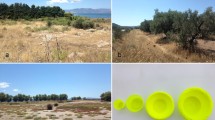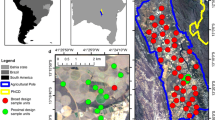Abstract
Various methods exist for collecting pollinating insects; however, colored bowl traps, vane traps, and sweep netting are among the most commonly used approaches, and may yield different estimates of insect abundance and taxa diversity depending on habitat type. Electric transmission rights-of-ways (ROWs) are found throughout the United States and provide early successional habitat which may provide an abundance of floral and nesting resources for many insect pollinators. Despite the potential for harboring pollinating insects, few researchers have focused on ROWs as important pollinator habitat. We surveyed pollinating insects (bees, wasps, flies, and lepidopterans) within ROWs and the surrounding habitat in central Alabama during spring and summer of 2018 using colored bowl traps (blue, yellow, and white), blue vane traps, and targeted sweep netting of insects on flowering plants. Overall, each collection method collected several bee genera and other pollinators that were not collected with the other methods. Blue vane traps collected more bee taxa and overall pollinating insect diversity compared to colored bowl traps and sweep netting. Sweep netting flowering plants collected the fewest pollinating insects but did document some genera that colored bowl traps and vane traps did not. Our data support the use of multiple collecting methods to document pollinator insect diversity and abundance.
Implications for insect conservation
This study suggests that accurately assessing insect pollinator abundance and diversity should not depend solely on one type of collecting method due to potential collection biases. Alternatively, if specific pollinator taxa are sought, utilizing certain collecting methods over others may enhance the probability of collection.





Similar content being viewed by others
References
Abbate A, Campbell JW, Bremer J, Kern WH (2018) The introduction and establishment of Campsomeris dorsata (Hymenoptera: Scoliidae) in Florida. Fla Entomol 101:543–546. https://doi.org/10.1653/024.101.0334
Andrieu E, Cabanettes A, Alignier A, Van Halder I, Alard D, Archaux F, Deconchat M (2018) Edge contrast does not modulate edge effect on plants and pollinators. Basic Appl Ecol 27:83–95. https://doi.org/10.1016/j.baae.2017.11.003
Berg Å, Ahrné K, Öckinger E, Svensson R, Wissman J (2013) Butterflies in semi-natural pastures and power-line corridors–effects of flower richness, management, and structural vegetation characteristics. Insect Conserv Divers 6:639–657. https://doi.org/10.1111/icad.12019
Bruckner S, Steinhauer N, Engelsma J, Fauvel AM, Kulhanek K, Malcolm E, Meredith A, Milbrath M, Niño EL, Rangel J, Rennich K, Reynolds D, Sagili R, Tsuruda J, van Engelsdorp D, Aurell SD, Wilson M, Williams G (2020) 2019–2020 Honey bee colony losses in the United States: preliminary results. Bee Informed Partnership. https://beeinformed.org/wp-content/uploads/2020/06/BIP_2019_2020_Losses_Abstract.pdf
Cameron SA, Lozier JD, Strange JP, Koch JB, Cordes N, Solter LF, Griswold TL (2011) Patterns of widespread decline in North American bumble bees. Proc Natl Acad Sci USA 108:662–667. https://doi.org/10.1073/pnas.1014743108
Campbell JW, Hanula JL (2007) Efficiency of Malaise traps and colored bowl traps for collecting flower visiting insects from three forested ecosystems. J Insect Conserv 11:399–408. https://doi.org/10.1007/s10841-006-9055-4
Campbell JW, Campbell BE, Kimmel CB, Galvan P (2016) Observations of insect visitors to price’s potato bean (Apios priceana, Fabaceae) in North Alabama, USA. Plant Ecol Evol 149:316–318. https://doi.org/10.5091/plecevo.2016.1232
Campbell JW, Vigueira PA, Vigueira CC, Greenberg CH (2018) The effects of repeated prescribed fire and thinning on bees, wasps, and other flower visitors in the understory and midstory of a temperate forest in North Carolina. For Sci 64:299–306. https://doi.org/10.1093/forsci/fxx008
Cane JH, Minckley RL, Kervin LJ (2000) Sampling bees (Hymenoptera: Apiformes) for pollinator community studies: pitfalls of bowl-trapping. J Kans Entomol Soc 73:225–231
Cavaletto G, Faccoli M, Marini L, Spaethe J, Magnani G, Rassati D (2020) Effect of trap color on captures of bark-and wood-boring beetles (Coleoptera; Buprestidae and Scolytinae) and associated predators. Insects 11(11):749. https://doi.org/10.3390/insects11110749
Chao A, Chun-Huo CH, Hsieh TC (2012) Proposing a resolution to debates on diversity partitioning. Ecology 93:2037–2051
de Quesada G, Kuuluvainen T (2020) Tree diametric-species diversity is affected by human impact in old Scots pine dominated forest in boreal Fennoscandia. For Ecosyst 7:8. https://doi.org/10.1186/s40663-020-0219-6
Desmarais BA, Harden JJ (2013) Testing for zero inflation in count models: bias correction for the Vuong test. Stata J 13:810–835. https://doi.org/10.1177/1536867x1301300408
Eisenhauer N, Bonn A, Guerra CA (2019) Recognizing the quiet extinction of invertebrates. Nat Commun 10:1–3. https://doi.org/10.1038/s41467-018-07916-1
Gibbs J, Joshi NK, Wilson JK, Rothwell NL, Powers K, Haas M, Gut L, Biddinger DJ, Isaacs R (2017) Does passive sampling accurately reflect the bee (Apoidea: Anthophila) communities pollinating apple and sour cherry orchards? Environ Entomol 46:579–588. https://doi.org/10.1093/ee/nvx069
Goldburg RJ (1987) Sequential flowering of neighboring goldenrods and the movements of the flower predator Epicauta pennsylvanica. Oecologia 74:247–252. https://doi.org/10.1007/BF00379366
Gollan JR, Ashcroft MB, Batley M (2011) Comparison of yellow and white bowl traps in surveys of bee fauna in New South Wales, Australia (Hymenoptera: Apoidea: Anthophila). Aust J Entomol 50:174–178. https://doi.org/10.1111/j.1440-6055.2010.00797.x
Graves TA, Janousek WM, Gaulke SM, Nicholas AC, Keinath DA, Bell CM, Cannings S, Hatfield RG, Heron JM, Koch JB, Loffland HL, Richardson LL, Rohde AT, Rykken J, Strange JP, Tronstad LM, Sheffield CS (2020) Western bumble bee: declines in the continental United States and range-wide information gaps. Ecosphere 11(6):e03141
Grodsky SM, Campbell JW, Hernandez RR (2021) Solar energy development impacts flower-visiting beetles and flies in the Mojave desert. Biol Conserv 263:109336. https://doi.org/10.1016/j.biocon.2021.109336
Gutierrez RG, Carter SL, Drukker DM (2001) On boundary-value likelihood-ratio tests. Stata Tech Bull 60:15–18
Hall HG (2016) Color preferences of bees captured in pan traps. J Kans Entomol Soc 89:273–276
Hall M (2018) Blue and yellow vane traps differ in their sampling effectiveness for wild bees in both open and wooded habitats. Agric for Entomol 20:487–495. https://doi.org/10.1111/afe.12281
Hall MA, Reboud EL (2019) High sampling effectiveness for non-bee flower visitors using vane traps in both open and wooded habitats. Austral Entomol 58:836–847. https://doi.org/10.1111/aen.12416
Hill B, Bartomeus I (2016) The potential of electricity transmission corridors in forested areas as bumblebee habitat. R Soc Open Sci 3:160525. https://doi.org/10.1098/rsos.160525
Hudson J, Horn S, Hanula JL (2020) Assessing the efficiency of pan traps for collecting bees (Hymenoptera: Apoidea). J Entomol Sci 55:321–328
Joshi NK, Leslie T, Rajotte EG, Kammerer MA, Otieno M, Biddinger DJ (2015) Comparative trapping efficiency to characterize bee abundance, diversity, and community composition in apple orchards. Ann Entomol Soc Am 108:785–799. https://doi.org/10.1093/aesa/sav057
Krauss J, Steffan-Dewenter I, Tscharntke T (2003) How does landscape context contribute to effects of habitat fragmentation on diversity and population density of butterflies? J Biogeogr 30:889–900. https://doi.org/10.1046/j.1365-2699.2003.00878.x
Leckie G (2010) Centre for multilevel modeling, LEMMA VLE. http://www.bristol.ac.uk/cmm/learning/online-course/index.html
Leston L, Koper N (2017) Urban rights-of-way as extensive butterfly habitats: a case study from Winnipeg, Canada. Landsc Urban Plan 157:56–62. https://doi.org/10.1016/j.landurbplan.2016.05.026
Magurran A (2004) Measuring biological diversity. Blackwell Publishing Ltd, Oxford
Mitchell MN (2012) Interpreting and visualizing regression models using Stata:. Stata Press. NCSS, Repeated measures analysis of variance. NCSS Stat. Softw. 2012:1–28. https://doi.org/10.1215/10757163-1496426
Park CN, Overall LM, Smith LM, Lagrange T, McMurry S (2017) Melittofauna and other potential pollinators in wetland and uplands in south central Nebraska (Insecta: Apoidea). Zootaxa 4242:255–280. https://doi.org/10.11646/zootaxa.4242.2.3
Pinto JD (1999) The new world genera of meloidae (coleoptera): a key and synopsis. J Nat Hist 33:569–620. https://doi.org/10.1080/002229399300254
Prendergast KS, Menz MH, Dixon KW, Bateman PW (2020) The relative performance of sampling methods for native bees: an empirical test and review of the literature. Ecosphere 11(5):e03076
R Core Team (2022) R: A language and environment for statistical computing. R Foundation for Statistical Computing, Vienna, Austria
Rader R, Bartomeus I, Garibaldi LA, Garratt MP, Howlett BG, Winfree R, Cunningham SA, Mayfield MM, Arthur AD, Andersson GK, Bommarco R (2016) Non-bee insects are important contributors to global crop pollination. Proc Natl Acad Sci USA 113:146–151. https://doi.org/10.1073/pnas.1517092112
Richards MH, Rutgers-Kelly A, Gibbs J, Vickruck JL, Rehan SM, Sheffield CS (2011) Bee diversity in naturalizing patches of Carolinian grasslands in southern Ontario, Canada. Can Entomol 143:279–299. https://doi.org/10.4039/n11-010
Roswell M, Dushoff J, Winfree R (2021) A conceptual guide to measuring species diversity. Oikos 130:321–338
Roulston TAH, Smith SA, Brewster AL (2007) A comparison of bowl trap and intensive net sampling techniques for documenting a bee (Hymenoptera: Apiformes) fauna. J Kans Entomol Soc 80:179–181
Russell KN, Ikerd H, Droege S (2005) The potential conservation value of unmowed power line strips for native bees. Biol Conserv 124:133–148. https://doi.org/10.1016/j.biocon.2005.01.022
Russell KN, Russell GJ, Kaplan KL, Mian S, Kornbluth S (2018) Increasing the conservation value of power line corridors for wild bees through vegetation management: an experimental approach. Biodivers Conserv 27:2541–2565. https://doi.org/10.1007/s10531-018-1552-8
Russo L, Stout H, Roberts D, Ross BD, Mahan CG (2021) Powerline right-of-way management and flower-visiting insects: how vegetation management can promote pollinator diversity. PloS one. 16(1):e0245146. https://doi.org/10.1371/journal.pone.0245146
Sanchez-Bayo F, Wyckhuys KAG (2019) Worldwide decline of the entomofauna: a review of its drivers. Biol Conserv 232:8–27
Sommaggio D (1999) Syrphidae: can they be used as environmental bioindicators? Agric Ecosyst Environ 74:343–356. https://doi.org/10.1016/S0167-8809(99)00042-0
Sribney W (2005) Why should I not do a likelihood-ratio test after an ML estimation (e.g., logit, probit) with clustering or pweights? StataCorp LP. http://www.stata.com/support/faqs/statistics/likelihood-ratio-test/
Steinert M, Sydenham MAK, Eldegard K, Moe SR (2020) Conservation of solitary bees in power-line clearings: sustained increase in habitat quality through woody debris removal. Glob Ecol Conserv 21:e00823. https://doi.org/10.1016/j.gecco.2019.e00823
Stephen WP, Rao S (2005) Unscented color traps for non-Apis bees (Hymenoptera: Apiformes). J Kans Entomol Soc 78:373–381
Templ B, Mózes E, Templ M, Földesi R, Szirák Á, Báldi A, Kovács-Hostyánszki A (2019) Habitat-dependency of transect walk and bowl trap methods for bee sampling in farmlands. J Apic Sci 63:93–115. https://doi.org/10.2478/JAS-2019-0014
U.S. Fish and Wildlife Service (2017) Rusty Patched Bumble Bee Midwest Plant Guide. Fact Sheet. https://www.fws.gov/midwest/endangered/insects/rpbb/factsheetrpbb.html
Wagner DL, Ascher JS (2008) Rediscovery of Epeoloides pilosula (Cresson) (Hymenoptera: Apidae) in New England. J Kans Entomol Soc 81:81–83. https://doi.org/10.2317/JKES-703.19.1
Wagner DL, Ascher JS, Bricker NK (2014) A transmission right-of-way as habitat for wild bees (Hymenoptera: Apoidea: Anthophila) in Connecticut. Ann Entomol Soc Am 107:1110–1120. https://doi.org/10.1603/AN14001
Wagner DL, Metzler KJ, Frye H (2019) Importance of transmission line corridors for conservation of native bees and other wildlife. Biol Conserv 235:147–156. https://doi.org/10.1016/j.biocon.2019.03.042
Wagner DL, Grames EM, Forister ML, Berenbaum MR, Stopak D (2021) Insect decline in the Anthropocene: death by a thousand cuts. Proc Natl Acad Sci USA 118(2):e2023989118
Westphal C, Bommarco R, Carré G, Lamborn E, Morison N, Petanidou T, Potts SG, Roberts SP, Szentgyörgyi H, Tscheulin T, Vaissière BE (2008) Measuring bee diversity in different European habitats and biogeographical regions. Ecol Monogr 78:653–671. https://doi.org/10.1890/07-1292.1
Wilson JS, Griswold T, Messinger OJ (2008) Sampling bee communities (Hymenoptera: Apiformes) in a desert landscape: are bowl traps sufficient? J Kans Entomol Soc 81:288–301. https://doi.org/10.2317/JKES-802.06.1
Wojcik VA, Buchmann S (2012) Pollinator conservation and management on electrical transmission and roadside rights-of-way: a review. J Pollinat Ecol 7:16–26
Woodley NE, Judd DD (1998) Notes on the host, egg, and puparium of Stylogaster biannulata (Say) (Diptera: Conopidae). Proc Entomol Soc Wash 100:658–664
Acknowledgements
We thank Alexandra Tsalickis, Hannah Langlois, Kyle Shoulders, and Wes Stone for field and lab assistance.
Funding
This work was supported by Alabama Power, Southern Company, and the Electric Power Research Institute.
Author information
Authors and Affiliations
Corresponding author
Ethics declarations
Conflict of interest
The authors declare they have no conflicts of interest.
Additional information
Publisher's Note
Springer Nature remains neutral with regard to jurisdictional claims in published maps and institutional affiliations.
Supplementary Information
Below is the link to the electronic supplementary material.
Rights and permissions
About this article
Cite this article
Campbell, J.W., Abbate, A., West, N.M. et al. Comparing three collection methods for pollinating insects within electric transmission rights-of-ways. J Insect Conserv 27, 377–387 (2023). https://doi.org/10.1007/s10841-023-00460-4
Received:
Accepted:
Published:
Issue Date:
DOI: https://doi.org/10.1007/s10841-023-00460-4




